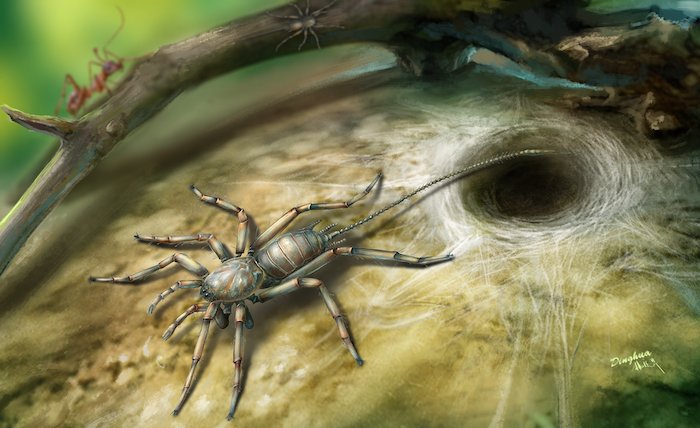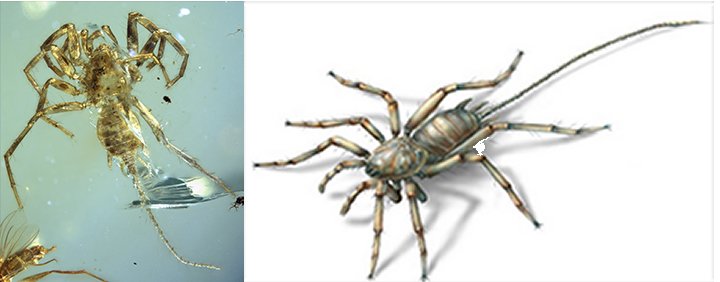nivek
As Above So Below
Spider With A Tail Found Preserved In Amber After 100 Million Years

A remarkable new species of arachnid, resembling a spider with a tail, has been discovered in amber from Myanmar (formerly Burma), of mid-Cretaceous age, around 100 million years ago.
The new animal resembles a spider in having fangs, male pedipalps, four walking legs and silk-producing spinnerets at its rear. However, it also bears a long flagellum or tail. No living spider has a tail, although some relatives of spiders, the vinegaroons, do have an anal flagellum.
Four new specimens have been found, and all are tiny, about 2.5 millimeters body length, excluding the nearly 3-millimeter-long tail.
“There’s been a lot of amber being produced from northern Myanmar and its interest stepped up about ten years ago when it was discovered this amber was mid-Cretaceous; therefore, all the insects found in it were much older than first thought,” said Paul Selden of the Paleontological Institute and Department of Geology at the University of Kansas.

Left: The entire specimen in dorsal ventral view. Right: Illustration of a remarkable arachnid from the mid-Cretaceous (approximately 100 million years ago) Burmese amber of Myanmar, which documents a key transition stage in spider evolution.
“We can only speculate that, because it was trapped in amber, we assume it was living on or around tree trunks,” he said. “Amber is fossilized resin, so for a spider to have become trapped, it may well have lived under bark or in the moss at the foot of a tree.”
While the tailed spider was capable of producing silk due to its spinnerets, Selden said it was unlikely to have constructed webs to trap bugs like many modern spiders.
“We don’t know if it wove webs,” said the KU researcher. “Spinnerets are used to produce silk but for a whole host of reasons — to wrap eggs, to make burrows, to make sleeping hammocks or just to leave behind trails. If they live in burrows and leave, they leave a trail so they can find their way back. These all evolved before spiders made it up into the air and made insect traps. Spiders went up into the air when the insects went up into the air. I presume that it didn’t make webs that stretched across bushes. However, like all spiders it would have been a carnivore and would have eaten insects, I imagine.”

A remarkable new species of arachnid, resembling a spider with a tail, has been discovered in amber from Myanmar (formerly Burma), of mid-Cretaceous age, around 100 million years ago.
The new animal resembles a spider in having fangs, male pedipalps, four walking legs and silk-producing spinnerets at its rear. However, it also bears a long flagellum or tail. No living spider has a tail, although some relatives of spiders, the vinegaroons, do have an anal flagellum.
Four new specimens have been found, and all are tiny, about 2.5 millimeters body length, excluding the nearly 3-millimeter-long tail.
“There’s been a lot of amber being produced from northern Myanmar and its interest stepped up about ten years ago when it was discovered this amber was mid-Cretaceous; therefore, all the insects found in it were much older than first thought,” said Paul Selden of the Paleontological Institute and Department of Geology at the University of Kansas.

Left: The entire specimen in dorsal ventral view. Right: Illustration of a remarkable arachnid from the mid-Cretaceous (approximately 100 million years ago) Burmese amber of Myanmar, which documents a key transition stage in spider evolution.
“We can only speculate that, because it was trapped in amber, we assume it was living on or around tree trunks,” he said. “Amber is fossilized resin, so for a spider to have become trapped, it may well have lived under bark or in the moss at the foot of a tree.”
While the tailed spider was capable of producing silk due to its spinnerets, Selden said it was unlikely to have constructed webs to trap bugs like many modern spiders.
“We don’t know if it wove webs,” said the KU researcher. “Spinnerets are used to produce silk but for a whole host of reasons — to wrap eggs, to make burrows, to make sleeping hammocks or just to leave behind trails. If they live in burrows and leave, they leave a trail so they can find their way back. These all evolved before spiders made it up into the air and made insect traps. Spiders went up into the air when the insects went up into the air. I presume that it didn’t make webs that stretched across bushes. However, like all spiders it would have been a carnivore and would have eaten insects, I imagine.”
